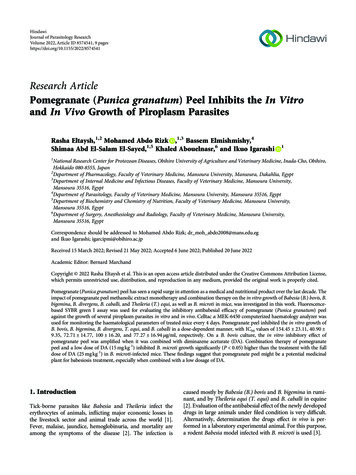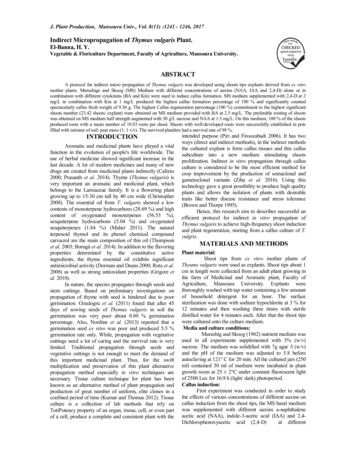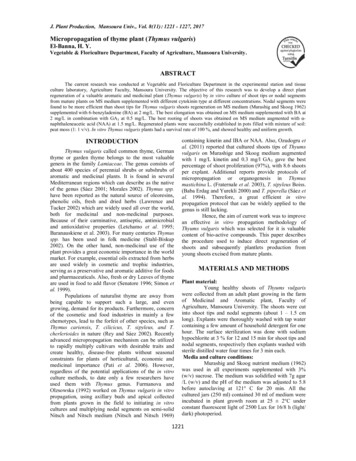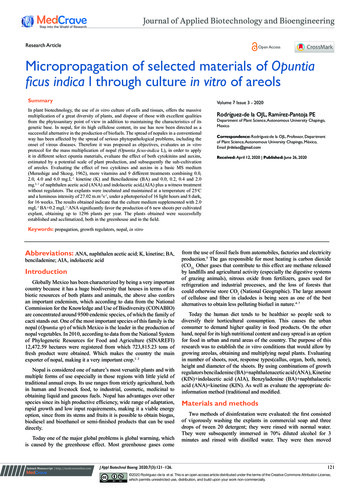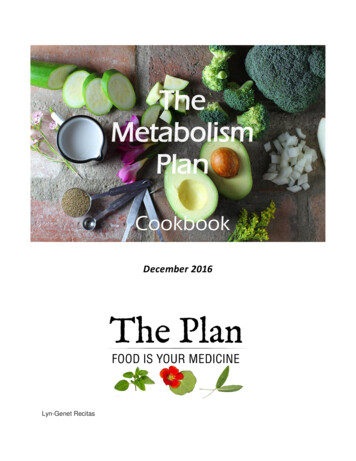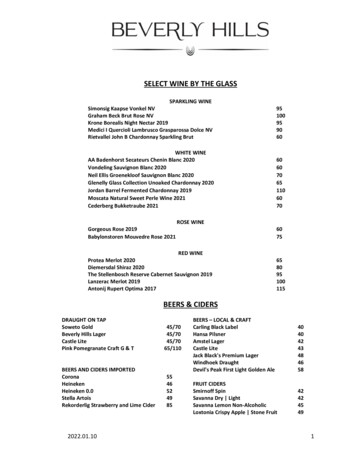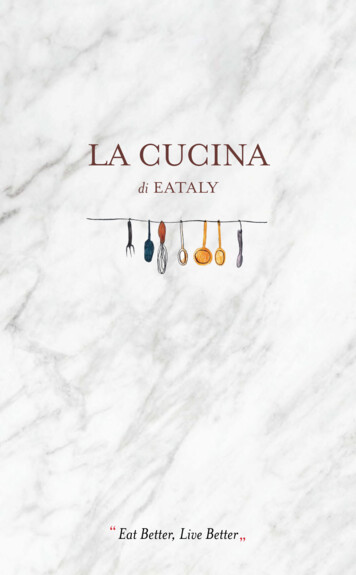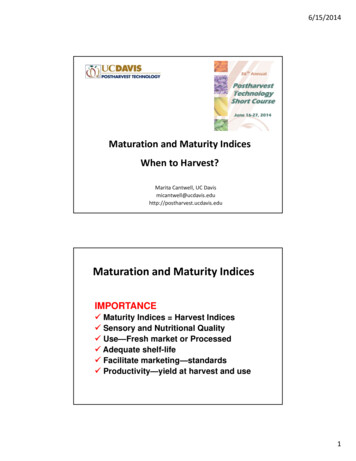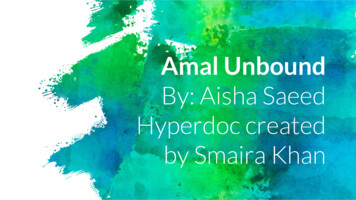
Transcription
African Journal of Biotechnology Vol. 10(79), pp. 18130-18136, 12 December, 2011Available online at http://www.academicjournals.org/AJBDOI: 10.5897/AJB11.1437ISSN 1684–5315 2011 Academic JournalsFull Length Research PaperMicropropagation of pomegranate (Punica granatum L.)‘Bhagava’ cultivar from nodal explantVijay M. Patil, G. A. Dhande*, Dipak M. Thigale and J. C. RajputNirmal Seeds Pvt. Ltd., Pachora, Jalgaon 424 201, Maharashtra, India.Accepted 15 September, 2011Reliable and reproducible protocols to get healthy and well formed plants from nodal explants of thepomegranate (Punica granatum L) cv ‘Bhagava’ has been developed. Nodal segments were cultured ontwo different media at full strength Murashige and Skoog (MS) and Woody Plant Medium (WPM). Themedia was prepared as a basal medium supplemented with 0.2 to 2 mg/L 6-benzylaminopurine (BAP),0.1 to 1 mg/L 1-naphthalacetic acid (NAA), 0.5 to 2.5 mg/L silver nitrate (AgNO3) and 10 to 50 mg/Ladenine sulphate for establishment stage. For proliferation stage, 0.1 to 0.5 mg/L BAP and NAA wastested. For rooting stage 0.0, 0.25 and 0.5 mg/L 3-Indolebutyric acid (IBA) and NAA on MS and WPMmedium were tested. The nodal explants grown on MS medium containing 1.8 mg/L BAP, 0.9 mg/L NAA,1 mg/L silver nitrate and 30 mg/L adenine sulphate had the highest proliferation rate (10 to 15shoots/explants) in establishment stage. The same trend was found concerning the maximum leavesnumbers (15 to 20 leaves/explants) on proliferation medium containing 0.4 mg/L BAP and 0.3 mg/L NAA.The plantlets grown on MS medium were found to have better survival compared to WPM medium. 0.5mg/L NAA and 0.5 mg/L IBA showed equal rooting response in both the medium, whereas thick rootformation was observed in the medium containing IBA.Key words: Micropropagation, proliferation, rooting, Punica granatum.INTRODUCTIONPomegranate (Punica granatum L.) is generally known ina distinct family (Punicaceae), which comprises only onegenus (Punica) and two species; P. granatum and P.protopunica (Samir, 2010). It is an economicallyimportant species of the tropical and subtropical regionsof the world due to its delicious edible fruits andpharmaceutical and ornamental usage (Jayesh andKumar, 2004). Pomegranate is considered native to Iran,Afghanistan and Southern Pakistan's Baluchistan regionto the Himalayas in Northern India. It has been widelycultivated throughout drier parts of Southeast Asia,Malaysia, the East Indies tropical Africa and India (Rajand Kanwar, 2008). In India, it is found from Kanyakumarito Kashmir but is cultivated commercially only inMaharashtra. Small-scale plantations are also seen inGujarat, Rajasthan, Karnataka, Tamil Nadu, Andhra*Corresponding author. E-mail: gauravdhande1@gmail.com.Tel: 91-2596-244366. Fax: 91-2596-244045.Pradesh, Uttar Pradesh, Punjab and Haryana (Vineeta,2010). The total area under pomegranate cultivation inIndia is 100,000 ha yielding 0.45 million tons of fruit peryear.The fruit juice is a good source of sugars, vitamin C,vitamin B, pantothenic acid, potassium, antioxidantpolyphenols and a fair source of iron. Some parts of thepomegranate tree (leaves, immature fruits, fruit rind andflower buds) have been used traditionally for theirmedicinal properties and also for tanning of leather. Wildpomegranate is too acidic and of little value except assouring agent (Anardana). The double-flowered pomegranates (which do not bear fruits) are grown in parksand ornamental gardens for their beautiful red flowers(Raj and Kanwar, 2010).Pomegranate is propagated vegetatively by the rootingof hard wood cuttings, although the establishment of newplants requires one year. Micropropagation in fruit treewould help in overcoming difficulties of vegetativepropagation, producing true to-type plants and rapid andmass production of planting materials (Samir et al.,
Patil et al.2009). Hence, several studies have been conducted onmicropropagation of pomegranate trees over the pastseveral years. Protocols have been developed forregeneration of P. granatum L. plantlets in vitro througheither organogenesis from callus derived from leafsegments, cotyledons (Murkute et al., 2002; Raj andKanwar, 2008; Kanwar et al., 2010), anthers (Naik et al.,1999) or through embryogenesis from various seedlingexplants, petals and immature zygotic embryos ( Kanwaret al., 2010).Consequently, this work was designed for micropropagation of pomegranate (P. granatum L.) ‘Bhagava’cultivar and to study the effect of medium type(Murashige and Skoog, and Woody plant medium) andgrowth regulators for establishment, multiplication androoting of pomegranate (P. granatum L.). In the presentcommunication, we reported for the first time, effect ofadenine sulphate and silver nitrate (ethylene inhibitor) onmicropropagation and overcome difficulties of vegetativepropagation for producing true to-type plants for rapidand mass multiplication through micropropagation of themost popularly grown pomegranate cultivar ‘Bhagava’.MATERIALS AND METHODSThis work was done in Tissue Culture Laboratory, BiotechnologyDivision; Nirmal Seeds Pvt. Ltd. (India) during the period fromAugust, 2009 to October, 2010 to establish micropropagationprotocol of one main pomegranate ‘Bhagava’ cultivar grown in India.18131media. After establishing transferred explants on proliferation mediafor growth, completely proliferated explants were then transferred torooting media.Culture mediaTwo different media; viz MS medium and WPM medium weretested for micropropagation of pomegranate cultivar ‘Bhagava’.Media was prepared as a basal medium supplemented with organicacids and vitamins. Sucrose was added at 30.0 g/L and myoinositolat 0.1 g/L. The pH of the prepared media was adjusted between 5.6to 5.8 and agar-agar (Hi-Media) was added as 8.0 g/L for mediasolidification. For establishment stage, BAP 0.2 to 2.0 mg/L, NAA0.1 to 1.0 mg/L, silver nitrate 0.5 to 2.5 mg/L and adenine sulphate10 to 50 mg/L were used while for proliferation stage, BAP 0.1 to0.5 mg/L and NAA 0.1 to 0.5 mg/L were tested. Also, for rootingstage, two different auxins; IBA and NAA were tested at 0.0, 0.25and 0.5 mg/L on MS and WPM medium at full strength.RESULTSEffect of BAP on regeneration of shootsFor the nodal explants grown on MS medium withdifferent concentration of BAP (0.2 to 2 mg/L), the highestaverage growth response (99%) was recorded on MSmedium containing BAP 1.8 mg/L, whereas 4 to 6 shootsper explants having highest shoot length (0.7 to 1.9 cm)was recorded at same concentration (Figure 1).Effect of NAA on regeneration of shootsExplant collectionThe plant was authenticated and a voucher specimen has beendeposited in the herbarium of the Kanishka Farm of Nirmal SeedsPvt. Ltd. (Neri- Wadgaon, Tq- Bhadgaon Dist- Jalgaon).Explant isolationResults for the nodal explants grown on MS medium withdifferent concentration of NAA 0.1 to 1 mg/L indicatedthat the highest average growth response (97%) wasrecorded on MS medium containing 0.9 mg/L NAA,whereas two to three shoots per explants having highestshoot length (0.7 to 1.1 cm) was recorded at sameconcentration (Figure 2).Nodal segments of about 2 to 3 cm long of pomegranate ‘Bhagava’cultivars were collected from mature trees.Explant sterilizationEffect of silver nitrate and adenine sulphate onregeneration of shootsIsolated nodal segments were cleaned under running tap water forabout 15 to 20 min. Anti-oxidant solution treatment was given toisolated nodal segments by soaking in antioxidant solution (150mg/L ascorbic acid and 100 mg/L citric acid) for 20 min. each underlaminar air flow hood and followed by three times rinsing in steriledistilled water. Nodal segments were further soaked in fungicide (M45) solution (1 mg/L) for 45 min. and then again washed with steriledistilled water. Streptomycin solution (100 mg/L) treatment was alsogiven to explants for 20 min. and then washed by sterile distilledwater. Finally 1 g/L mercuric chloride solution for 10 min. was usedto treat these explants followed by three times washes with steriledistilled water for complete sterilization of nodal explants.The nodal explants grown on MS medium with differentconcentration of silver nitrate (0.5 to 2.5 mg/L) andadenine sulphate (10 to 50 mg/L), three to six shoots perexplants was recorded in the medium having 1 mg/Lsilver nitrate, while three to five shoots per explants wererecorded on the medium containing 30 mg/L adeninesulphate (Figure 3). The data in Table 1 shows that thehighest average growth response (96 and 97%) wasrecorded on MS medium containing silver nitrate and 30mg/L adenine sulphate, respectively.InoculationEffect of NAA and IBA in MS medium on rootingCompletely sterilized explants were inoculated on establishmentThe MS medium containing 0.5 mg/L NAA and 0.5 mg/L
18132Afr. J. Biotechnol.Figure 1. Plants showing the highest average growth responseas recorded on MS medium containing 1.8 mg/L BAP.Figure 3. The highest average growth response as recorded onMS medium containing 1.0 mg/L silver nitrate and 30 mg/Ladenine sulphate.Effect of different media viz. MS and WPM mediumfor shoot regenerationThe data in Table 3 shows that the highest averagegrowth and regeneration of 10 to 15 shoots per explantswas recorded on MS medium compared to the six toeight shoots per explants on WPM medium containing1.8 mg/L BAP, 0.9 mg/L NAA, 1 mg/L silver nitrate and30 mg/L adenine sulphate (Figures 6 and 7).Effect of BAP and NAA in proliferation medium onleaf inductionFigure 2. Plants showing the highest average growth responseas recorded on MS medium containing 0.9 mg/L NAA.IBA showed the highest rooting response. The data inTable 2 shows that the highest average rooting responsewas recorded on MS medium containing 0.5 mg/L NAA(97%) and 0.5 mg/L IBA (97%). Both NAA and IBAtherefore showed same rooting response (Figures 4 and5). However, thick root formation was observed inmedium containing 0.5 mg/L IBA. Root length of 0.3 to3.4 cm was recorded on medium containing IBA,whereas 1.3 to 3.2 cm root length was recorded onmedium containing NAA.For the nodal explants grown on MS medium withconcentration of 0.1 to 0.5mg/L of BAP and NAA, thedata in Table 4 shows that the highest average maximumleaf number (15 to 20) was recorded on MS mediumcontaining 0.4 mg/L BAP and 0.3 mg/L NAA. Similarly 98and 96% explants showed maximum leaf formation inproliferation medium having same concentration of BAPand NAA, respectively (Figure 8).DISCUSSIONWe were successful in developing a protocol for themicropropagation of pomegranate (P. granatum L.)
Patil et al.18133Table 1. Effect of silver nitrate and adenine sulphate in MS medium on the rates of nodal explants regenerating shoots forestablishment stage.S/NMedium12345678910MS Silver nitrateMS Silver nitrateMS Silver nitrateMS Silver nitrateMS Silver nitrateMS Adenine sulphateMS Adenine sulphateMS Adenine sulphateMS Adenine sulphateMS Adenine sulphateConcentration(mg/L)Number of shoot/explant% of explants showingresponseShoot length (cm)0.51.01.52.02.510203040504 16 14 13 12 13 14 15 14 13 187 196 183 177 169 175 195 197 186 172 11.9 0.92.5 1.31.6 0.50.9 0.30.7 0.10.6 0.21.2 0.62.5 0.80.7 0.30.5 0.1Table 2. Effect of NAA and IBA in MS medium on rooting.S/NMedium123456MS IBAMS IBAMS IBAMS NAAMS NAAMS NAAConcentration (mg/L)Number of root/ explant% of explants showing responseRoot length (cm)0.00.250.500.00.250.501 14 16 11 14 16 120 182 197 115 180 197 10.3 0.21.5 0.23.4 0.51.3 0.22.5 0.23.2 0.5Figure 4. MS medium containing 0.5 mg/L NAA showing thehighest rooting response.Figure 5. MS medium containing IBA 0.5 mg/L shows highestrooting response and thick root formation.
18134Afr. J. Biotechnol.Table 3. Effect of BAP, NAA, silver nitrate and adenine sulphate in MS medium and Woody Plant Medium on the rates of nodal explantsregenerating number of shoots per explant.S/NMedium12MS MediumWPM MediumBAP(1.8 mg/L)5 13 1Number of shoot/ explantNumber of shoot/ explantNAASilver nitrate Adenine sulphateBAP NAA AgNO3 Adenine sulphate(0.9 mg/L)(1 mg/L)(30 mg/L)3 16 15 112 32 14 12 17 1Figure 6. MS medium containing BAP, NAA, silver nitrate andadenine sulphate show highest shoot regeneration.‘Bhagava’ cultivar using two different media combinationMS and WPM. MS medium proved to produce bestvegetative growth characteristics compared to WPMmedium. However in contrast to our findings Samir et al.(2009) found that WPM is best for vegetative growthcompared to MS and NN medium.Micropropagation establishment from field grown plantsis a very critical process as it is met with an array ofdifferent problems such as microbial contamination,phenol exudation, etc. Phenol secretion from the cut endsof explants leads to browning of the medium and reducesdevelopment of explants. To avoid and minimize thisproblem, various workers tried the use of fungicide (M 45), streptomycin, mercuric chloride and antioxidantsolution (ascorbic acid and citric acid) etc. and suchcompounds have been suggested to control phenolexudation (Naik et al., 1999, Murkute et al., 2002). Wewere successful in developing a protocol for surfacesterilization by using fungicide (M - 45), streptomycin, andmercuric chloride. 85 to 90% reduction in contaminationwas observed using this treatment. We also usedantioxidant solution (ascorbic acid and citric acid; 150Figure 7. WPM containing BAP, NAA, silver nitrate and adeninesulphate showing lower shoot regeneration as compared to MSmedium.mg/L and 100 mg/L respectively) to reduce the phenolsecretion and transferred the explants to fresh medium.NAA and BAP combinations were rewarding in manyfruit tree species (Zimmerman and Swartz, 1994). For theshoot regeneration, cytokinin is effective when used incombination with an auxin (Nike et al., 1999). Synthesisand activities of auxin, cytokinins and ethylene arethought to be closely related (Klee and Romano, 1994).Ramesh et al. (2006) also reported that the addition ofadenine sulphate (60 mg/L) along with other growthregulators was the most effective in inducing shootmultiplication. It is also well documented that silver nitrate(Nike et al., 2003), as well as adenine sulphate promotesshoot multiplication (Shrivastava and Banerjee, 2008).Our report also support that the presence of silver nitrateshow remarkable improvement in shoot multiplication rateof pomegranate. Silver nitrate alone at concentration of 1
Patil et al.18135Table 4. Effect of BAP and NAA in MS medium on the rates of nodal explants regenerating maximum leaves for proliferationstage.S/NMedium12345678910MS BAPMS BAPMS BAPMS BAPMS BAPMS NAAMS NAAMS NAAMS NAAMS NAAConcentration(mg/L)Number of leaves/explants% of explantsshowing responseShoot length (cm)0.10.20.30.40.50.10.20.30.40.511 114 115 119 117 112 115 118 116 114 135 140 185 198 182 157 177 196 187 189 10.6 0.10.9 0.31.6 0.82.0 0.61.4 0.21.0 0.21.1 0.41.5 1.01.5 0.91.2 0.6Figure 8. MS medium containing BAP and NAA showingmaximum leaf numbers (15 to 20) at proliferation stage.mg/L produced average shoot multiplication number ofthree to six shoots per explants after two week ofinoculation. This is also in agreement with Nike et al.(2003), who observed similar result with cotyledon tissueof pomegranate. The average height of shoots varied inthe range of 2.5 to 3 cm (Table 1). On the other handadenine sulphate alone showed the multiplication rate ofthree to five shoots per explants in 10 to 50 mg/L,respectively. Maximum numbers of shoots were found atthe optimum concentration of adenine sulphate (30mg/L). In general, the combination of silver nitrite andadenine sulphate gave significantly higher multiplicationrate. The highest shoot multiplication per explant wasrecorded in MS medium supplemented with silver nitrite(1 mg/L) in combination with adenine sulphate (30mg/L)(Table 1). 97% explants showed shooting response tocombination of silver nitrate and adenine sulphate.In this study, we used BAP (cytokinin), NAA (auxin),silver nitrate (ethylene inhibitor), and adenine sulphate(amino acid) for shoot regeneration. The highest numberof shoot per explants was observed on MS mediumcontaining 1.8 mg/L BAP, 0.9 mg/L NAA, 1.0 mg/L silvernitrate and 30 mg/L adenine sulphate with sucrose (30%)in comparison with WPM medium. In both WPM and MSmedium when different levels of alone BAP and NAAwere tried, WPM medium showed poor proliferationresponse compared to MS medium. Same trend wasfound concerning the maximum number of leaves onproliferation medium containing 0.4 mg/L BAP and 0.3mg/L NAA. The plantlets grown on MS medium werefound to have a better survival compared to WPMmedium.It has been reported by several researchers that NAAinduced rooting in P. granatum L. (Omura et al., 1987;Mahishni et al., 1991; Yang and Ludders, 1993; Amin etal., 1999; Naik et al., 2000; Naik and Chand, 2003; Zhu etal., 2003). Contrary to this findings, rooting inregenerated shoots from cotyledon derived calluscultures of P. granatum L. cv. ‘Ganesh’ was observed inhalf strength MS medium supplemented with IBA byMurkute et al. (2004). In this experiment, when proliferated shoots were subjected to in vitro rooting andshoot elongation in MS medium containing IBA and NAAat 0.5 mg/L respectively with 30% sucrose, same rootingresponse was observed in both NAA and IBA containingmedium. However, thick root formation was observed inmedia containing 0.5 mg/L IBA.We therefore succeeded in the development of anefficient protocol by using plant growth regulators incombination with silver nitrate and adenine sulphate formass scale micropropagation of pomegranate (P.granatum L.) ‘Bhagava’ cultivar. Hence, it is expectedthat this protocol can be used for constant supply of highvalued pomegranate (P. granatum L.) ‘Bhagava’ cultivartissue culture plants and also to demonstrate the role ofsilver nitrate and adenine sulphate alone or incombination with BAP and NAA in MS medium to inducehigh frequency adventitious shoot regeneration.
18136Afr. J. Biotechnol.REFERENCESAmin MN, Islam MN, Azad MAK (1999). Regeneration of plantlets invitro from the seedling explants of pomegranate (Punica granatumL.). Plant Tissue Cult. 9(1): 53-61.Jayesh KC, Kumar R (2004). Crossability in pomegranate (Punicagranatum L.). Indian J. Horticulture. 61: 3.Kanwar K, Joseph J, Raj D (2010). Comparison of in vitro regenerationpathways in Punica granatum L. Plant Cell, Tissue Organ Culture100(2): 199-207.Klee HJ, Romano CP (1994). The role of phytohormones indevelopment as studies in transgenic plants. Crit. Rev. Plant Sci. 13:311-324.Mahishni DM, Muralikishna A, Shivashankar G, Kulkarni RS (1991).Shoot tip culture method for rapid clonal propagation of pomegranate(Punica granatum L.). In: Horticulture New Technologies andApplications. Proc. Int. Seminar on New Frontiers in Horticulture.Indo-American Hybrid Seeds. Bangalore, pp. 215-217.Murkute AA, Patil S, Patil BN, Kumari M (2002). Micropropagation inpomegranate, callus induction and differentiation. South Indian Hort.50(1, 3): 49-55.Murkute AA, Patil S, Singh SK (2004). In vitro regeneration inpomegranate cv. Ganesh from mature trees. Indian J. Hort. 61(3):206-208.Naik SK, Pattnaik S, Chand PK (1999). In vitro propagation ofpomegranate (Punica granatum L. cv. Ganesh) through axillaryshoots proliferation from nodal segments of mature tree. ScientiaHorticulturae, 79: 175-183.Naik SK, Pattnaik S, Chand PK (2000). High frequency axillary shootproliferation and plant regeneration from cotyledonary nodes ofpomegranate (Punica granatum L.). Sci. Hortic. 85: 261-270.Naik SK, Chand PK (2003). Silver nitrate and aminoethoxyvinylglycinepromote in vitro adventitious shoot regeneration of pomegranate(Punica granatum L.). J. Plant Physiol., 160: 423-430.Omura M, Matsuta T, Moriguchi T, Kozaki I (1987). Adventitious shootand plantlet formation from cultured pomegranate leaf explants. Hort.Sci. 22: 133-134.Raj D, Kanwar K (2008). Efficient in vitro shoot multiplication and rootinduction enhanced by rejuvenation of microshoots in Punicagranatum cv. Kandhari Kabuli. National Seminar on Physiological andBiotechnological Approaches to Improve Plant Productivity,CCSHAU, Hisar, India, p. 24.Raj D, Kanwar K (2010). In vitro regeneration of (Punica granatum) L.Plants from different juvenile explants. J. Fruit Ornamental Plant Res.18(1): 5-22.Ramesh M, Saravanakumar RM, Pandain SK (2006). Benzyl aminopurine and adenine sulphate induced multiple shoot and rootinduction from nodal explants of Brahmi (Bacopa monnieri L). Penn.Nat. Prod. Rad. 5: 44‐51.Samir Z, El-Agamy, Rafat AA, Mostafa, Mokhtar M, Shaaban, Marwa T,El-Mahdy (2009). In vitro Propagation of Manfalouty and Nab Elgamal Pomegranate Cultivars Research. J. Agric. Biol. Sci. 5(6):1169-1175.Samir Z (2010). In vitro Salt and Drought Tolerance of Manfalouty andNab El-Gamal Pomegranate Cultivars. Australian. Basic Appl. Sci.4(6): 1076-1082.Shrivastava S, Banerjee M (2008). In vitro clonal propagation of physicnut (Jatropha curcas L.): influence of additives. Int. J. of IntegrativeBiol. 3: 73-79.Vineeta S (2010). Micropropagation of Pongamia pinnata (L.). Pierre- aNative Indian Biodiesel Tree from Cotyledonary Node. Int. J.Biotechnol. Biochem. 6(4): 555-560.Yang ZH, Ludders P (1993).Organogenesis of Punica granatum L. var.Nana. Angewandte Botanik, 67(5-6): 151-156.Zimmerman RH, Swartz HJ (1994). In vitro culture of temperate fruits.In: Vasil IK, Thorpe TA (eds). Plant Cell Tissue Culture. KluwerAcademic Publishers, Dordrecht, pp. 457-474.Zhu LW, Zhang SM, Song FS, Gong XM, Fang WJ, Sun J, Li SW(2003). Regeneration system of pomegranate by in vitro culture.Acta. Hort. Sinica, 430(2): 207-208.
Vijay M. Patil, G. A. Dhande*, Dipak M. Thigale and J. C. Rajput Nirmal Seeds Pvt. Ltd., Pachora, Jalgaon 424 201, Maharashtra, India. Accepted 15 September, 2011 Reliable and reproducible protocols to get healthy and well formed plants from nodal explants of the pomegranate ( Punica granatum L) cv 'Bhagava' has been developed.
